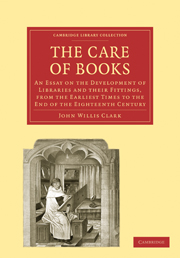 The Care of Books
The Care of Books Book contents
Summary
If the evidence brought forward in the last chapter be accepted, the library which a monastery or a college built in the fifteenth century was a long, narrow room lighted by rows of equidistant windows. Occasionally, if neighbouring buildings allowed, there was a window at the end of the room also. The fittings were lecterns of wood. On these the books were laid, each volume being fastened by a chain to a bar usually placed over the desk, but occasionally, in all probability, in front of it or beneath it. The readers sat on benches immoveably fixed opposite to each window. It is obvious that reading under these conditions would be convenient enough so long as the students were few, but if they were numerous and the books chained too closely together much annoyance must have been caused. When the University of Oxford petitioned Humphrey Duke of Gloucester in 1444 to help them to build a new library, they specially dwelt upon the obstacles to study arising from the overcrowded condition of the old room. “Should any student,” they said, “be poring over a single volume, as often happens, he keeps three or four others away on account of the books being chained so closely together.”
Further, the lectern-system was so wasteful in the matter of space, that, as books accumulated, some other piece of furniture had to be devised to contain them.
- Type
- Chapter
- Information
- The Care of BooksAn Essay on the Development of Libraries and their Fittings, from the Earliest Times to the End of the Eighteenth Century, pp. 165 - 192Publisher: Cambridge University PressPrint publication year: 2009First published in: 1902


